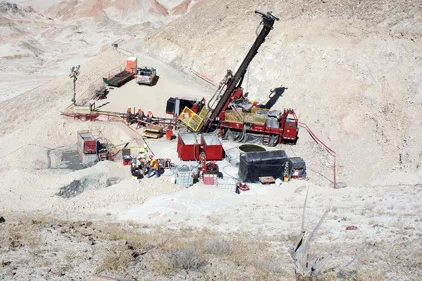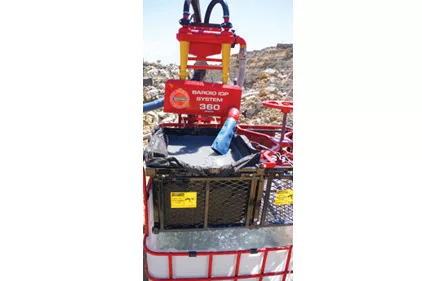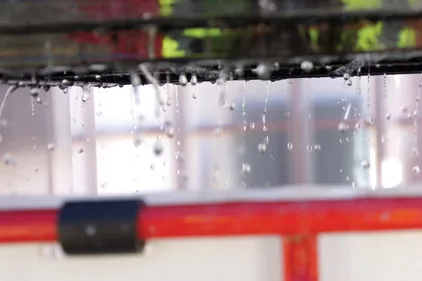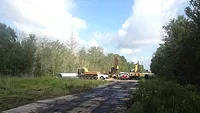System Helps Reduce Fluids, Impact on Jobsites
Managing What Comes Out, Goes into Boreholes Is Key for Remote Work


The flocs of the System 360 prior to pressing. Pressing the flocs assures more volume faster and yields dry waste for disposal. Source: Baroid IPD

The fluid phase of the System 360 allows drillers to repurpose water on-site, reducing the need to truck in water for a project. Source: Baroid IPD
Water is essential to all living and many non-living operations. Over half of the human body is comprised of water, and if the total amount of water in a human body decreases too much, it ceases to function properly.
A wireline coring operation depends on water in the same ways nature depends on it. Wireline coring fluid starts as 97 percent water. Wireline coring operations struggle with the availability of water. We rarely set up a wireline core rig to explore for precious metals such as gold or silver next to a water hydrant. Generally, the rig is set up on a location with poor road access or the need to fly in every component required to finish the hole by helicopter. Water needed to reach total depth and remove drill cuttings can have the biggest impact on remote project cost. The System 360 fluid management system is designed for remote projects with limited access to a water source, as well as to meet the need to minimize impact to the surrounding environment. The System 360 fluid management system can reduce water usage, sump size and the typical mud bill by 40 percent.
To better understand how the System 360 system works, let’s discuss the life of a wireline drilling fluid. The building blocks of wireline drilling fluids are water and desirable solids. Desirable solids consist of engineered ratios of sodium bentonite, specialty polymers, surfactants and lubricants. As drilling progresses, the desirable solids are exchanged for undesirable solids. Undesirable solids are created by the energy of the bit turning down hole. Undesirable solids include everything encountered in the down-hole environment such as clay, sands, rock and any mineralization zones.
All mud drilling disciplines generate undesirable solids. The difference between each discipline is the size of solids created by the bit. In water well drilling, the size of the solids coming up hole range from very large half dollar size solids to very fine colloidal size. In wireline coring, the solids’ size is smaller than sand (74 microns) and averages between 40 to 60 microns. The smaller the undesirable solid, the harder it is to remove from the drilling fluid. Half-dollar size solids in water well drilling generally settle out once they get to the pit, but a 20-micron solid will remain suspended in the drilling fluid and recirculate back down hole. As undesirable solids build up in the fluid, problems start to occur down hole, such as borehole destabilization, mud rings, stuck core tubes, induced lost circulation and broken wirelines. Issues related to undesirable solids buildup generally start with a fluid as low as 8.6 ppg in wireline coring.
The System 360 fluid management system is a two-stage solids removal and water recovery unit. The first stage utilizes hydro-cyclone de-silting cones specifically designed to remove undesirable solids created by a wireline coring bit. In the first stage, the mud is pumped through the de-silting cones removing solids that are less than 74 microns in size. The cones remove the solids by centrifugal separation, creating two types of output fluid streams: (1) overflow and (2) underflow. The overflow is 80 percent of the fluid that is pumped into the cones and returned back to the drill. The overflow density will be lower than the initial 8.6 ppg fluid that is being cleaned. The other 20 percent of the fluid is the underflow discharge stream at the bottom of the cones. This discharge stream contains a high concentration of undesirable solids and is considered a waste stream to be discarded in most solids control units.
Water recovery is the second stage of the System 360 unit. This process flocculates the underflow and captures the water phase the newly flocculated underflow solids. As the underflow stream collects at the bottom of the cones it is introduced to System Floc-360 Flocculent. The flocculent mixes with the underflow and collects in a specifically engineered dewatering bag below the System 360 manifold. The flocculent causes the solids to bind together and facilitates clear water effluent break out. The clear water effluent collects at the bottom of the catch tank and is used to make new drilling fluid. The dewatered solids left in the dewatering bag continue to dry out and after 24 hours are completely dry. The dried solids can be disposed of much more easily than solids-laden drilling fluid.
In the past two years System 360 has been implemented around the world in such places as Australia, Mexico, Guatemala, Peru and North America. Two notable projects where System 360 made a major impact are southern Peru and northeast Washington. In southern Peru, a mining company wanted to reduce the amount of water needed to finish each 1,200 meter hole. System 360 was able to reduce the water needed to complete a hole by 80 percent. This was significant because a water haul took four hours round trip on very dangerous haul roads. By reducing the amount of water required, the mud bill was reduced by 40 percent and sump size was reduced by 90 percent. In three months the contractor did not have any stuck tubes or broken wirelines. The mining company now requires all contractors to use System 360.
In northeast Washington, a mining company was under scrutiny to reduce the environmental impact on their exploration drill sites. The Forest Service and Bureau of Land Management required the company to eliminate sumps and reduce the amount of water used to complete a hole. System 360 was implemented on the site and the drilling contractor was able to go completely sumpless while also reducing the size of the drilling pad sites. In one month, the water usage was reduced by 60 percent and the mud bill was reduced by 35 percent. The contractor no longer had to pump off 1,500 gallons of solids laden mud twice a day. The project saved money and water, and the system helped improve safety by reducing the number of large trucks driven on dangerous primitive roads.
The System 360 fluid management system has demonstrated its value in reducing job costs and the environmental impact of a wireline core drill. Optimizing water usage is not only economical for a project, but is important for the sustainability of all life and the environment. Overall, System 360 can help conserve water, save money and promote environmental responsibility.
Looking for a reprint of this article?
From high-res PDFs to custom plaques, order your copy today!







